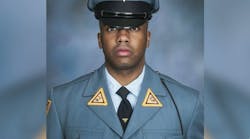\When police officers are faced with using deadly force they must rely on their training and their split-second judgment before making a life-altering decision.
In the world of police training, when it comes to the use of deadly force, officers are taught to "shoot to stop," an expression that over time and in movies and television has been changed, incorrectly, to "shoot to kill."
"We have split seconds to make a decision that laymen could have minutes, hours, days, weeks and months to make," said Anthony P. Saduk, director of the Cape May County Police Academy.
Derreck Mack, 18, was fatally shot by an Atlantic City police officer around 2 p.m. Monday after running from police and ignoring repeated commands to stop and drop his weapon, according to prosecutors, who are conducting an investigation of the shooting.
A 14-year veteran of the Atlantic City Police Department fired at Mack because he "feared for his life" upon seeing Mack reach into his waistband for a gun, the officer told investigators.
As is protocol, the officer -- who also works as a trainer at the Cape May County Police Academy, Saduk said -- has been placed on administrative leave pending the conclusion of the investigation.
Mack, who was on probation for illegal weapon possession at the time, was struck twice on the back of his upper left torso and pronounced dead shortly afterward at the hospital. Witness statements provided to the Atlantic County Prosecutor's Office conflict on what Mack was doing just before he was shot: surrendering or drawing the .45-caliber semiautomatic handgun found near his body.
The state Attorney General's Use of Force Policy states that "a law enforcement officer may use deadly force to stop a fleeing suspect from escaping if there is probable cause to believe the suspect has committed an offense in which the suspect caused or attempted to cause death or serious bodily harm; and who will pose an imminent danger of death or serious bodily harm should the escape succeed."
The mandated firearm training that police officers receive is continuous from the time they leave the academy and throughout their time on the job, Saduk said.
Some of that training includes simulated scenarios done at the academy that use weapons that look, feel and fire like a regular police weapon but use a type of paintball pellet, he said. The room features training simulators that use lasers to provide almost real-life shooting situations.
This type of training is referred to as force on force training that teaches officers how to effectively deliver fire while under pressure, said Barnegat Township Lt. Keith Germain, who is also a firearms instructor.
"Simulated training has real physiological reactions that officers will deal with at a scene. These are all things that we don't get on the range during shooting, and the departments that have force on force training have higher rate of accuracy," Germain said.
Training officers to handle their firearms effectively is one part of police training, but if you ask Atlantic City activist Steve Young, police in his community are skipping an equally important part -- getting to know the people in the community.
"How can you train officers without knowing what's going on or who is in the community? It's not only about the arrests, it's about the social part of the community," said Young who has spoken out against the officer's actions in the days after the shooting of Mack.
Young said activists and members of the community have called on the city and Police Department to require sensitivity training for officers and form a civilian review board but nothing has been done.
In May, Atlantic City officials began the process of creating a public safety civilian review board to better address allegations by residents and tourists of harassment and excessive force by Atlantic City police. But the board has not yet been established.
Before police shoot or aim at someone's body there should always be a warning shot fired or officers should shout, "stop or I'll shoot," Young said.
"Absolutely this should have been employed here. I believe that would have made a big difference," Young said.
But the the state Use of Force Policy does not allow an officer to "discharge a weapon as a signal for help or as a warning shot."
"What goes up must come down and that can be dangerous. We don't fire shots in the air anymore," Saduk said.
Within the profession, police have a accuracy rate of only about 15 percent, Germain said.
"The bottom line is we don't have the benefit of hindsight. We have to make a decision under extreme stress and duress while someone is at most times trying to kill us. We don't get to wait, and we shouldn't have to wait, as police officers, for someone to try and kill us first," Germain said.
Aiming for "center mass" on a subject when using deadly force goes hand in hand with law enforcement's mantra "shoot to stop," said Chief Charles Dishon, of the Ocean County Police Academy. Center mass is considered the largest portion of the body, depending on if the person is standing, sitting, crouching or in some other position.
This technique is taught at the academy to recruits during their shooting range instruction that includes a week of classroom learning and six days on the firing range as part of 22 1/2 week academy training, Dishon said.
Under the Use of Force Policy, police officers may use deadly force if they believe "the action is immediately necessary to protect the officer or another person from imminent danger of death or serious bodily harm."
"When you use deadly force you are essentially saying you are in fear for your life and the lives of others around you. But if you aim for the leg or arm you're not really in fear because you think can slow them down. If you have time to do that you have no business shooting them in the first place," Germain said.
Copyright 2012 - The Press of Atlantic City, Pleasantville, N.J.
McClatchy-Tribune News Service


